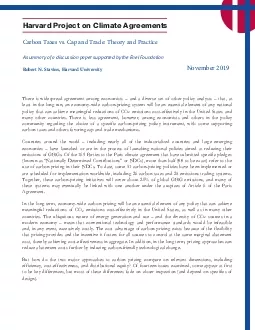

of a discussion paper supported by the Enel FoundationwwwhksharvardeduhpcaBeginning with similarities and symmetries first the two instruments are perfectly equient in regard to ncentives for emissio ID: 882956
Download Pdf The PPT/PDF document "There is widespread agreement among econ..." is the property of its rightful owner. Permission is granted to download and print the materials on this web site for personal, non-commercial use only, and to display it on your personal computer provided you do not modify the materials and that you retain all copyright notices contained in the materials. By downloading content from our website, you accept the terms of this agreement.
1 There is widespread agreement among econ
There is widespread agreement among economsts – and a diverse set of other policy analysts – that, at east in the long run, an economy-wide carbon-pricing system wi be an essential element of any national policy that can achieve meaningful reductions of CO2 emissions cost-effectively in the Uni of a discussion paper supported by the Enel Foundation www.hks.harvard.edu/hpca Beginning with similarities and symmetries, first, the two instruments are perfectly equient in regard to: ncentives for emission reduction, as both can be set upstream on the carbon content of fuels; aggregate abatement costs, as both can be cost-effective and provide the same incentives for technological change; and their effects on competitiveness, as both can lessen such impacts via appropriate border adjustments. econd, carbon taxes and cap-and-trade are nearly equivalent in regard to possibilities for raising revenue. (Cap-and-trade can employ an auction.) Third, these instruments are similar in terms of: costs to regulated rms, because cap-and-trade can freely allocate allowances, and a tax system can provide inframarginal exemptions below a specified level of emissions; and distributional impacts, as they can be designed to be roughly equivalent.Turning to differences and distinctions between the two carbon-pricing instruments, first, there are istinctions in terms of transaction costs, because volume discounts from brokers in a cap-and-trade system can violate the key property of the independence of costs and effectiveness of performance from the initial allocation of the allowances. Second, there are subtle differences in regard to: performance in the presence of uncertainty, as the Weitzman rule, which would seem to favor taxes because of the stock externality nature of the problem, can be overwhelmed by the correlation of benefits with costs, due to the persistence of technology shocks; and possibilities for linkage with other jurisdictions, since heterogeneous linkage is eminently possible.Third, there are sificant differences in regard to: carbon-price volatility, an issue only in cap-and-tradsystems, although this can be somewhat ameliorated with price colars and banking of alowances; nteractions with complementary policies, which is less of an issue with carbon taxes, which eliminate the so-called waterbed effect; market manipulation; and complexity and administrative requirements, which would seem to favor taxes, although whether a tax remains simple as it works its way through a legislature s an empirical questiAmong many findings from this survey and synthesis, one major conclusion stands out: The specific esigns of carbon taxes and cap-and-trade systems may be more consequential than the choice between the two instr
2 uments. These two approaches to carbon p
uments. These two approaches to carbon pricing are perfectly or nearly equivalent in regard to some issues and attributes, while significantly different in regard to some others. But many of these ifferences fade with specific implementation choices, as elements of design foster greater symmetry. Indeed, what appears at first to be a dichotomous choice between two distinct policy instruments often turns out to be a choice of design elements along a policy contiat:https://www.belfercenter.org/publication/carbon-taxes-vs-cap-and-trade-theory-and-practicendowment for Environmental Economics at Harvard University for generous support of a series which this paper is the Therewidespreadagreementeconomistsdiversesetothercyanalyststhat,at easttheeconomy-widecarbon-pricingsystemwiessentialelementnational policythatcanachieveeaningfulreductionsemissionscost-effectivelytheUnitedStatesothercountries.Thereessagreement,however,economistsothersthepolicy communityregardingthechoicespecificcarbon-pricingpolicynstrument,withsupporting carbon taxes and others favoring cap and trade mechanisms. Countriestheworldnearlythendustrializedcountrieslargeemerging economiesaunchedtheprocessaunchingnationalpoliciesaimedreducitheir emissions of GHGs. Of the 169 Parties to the Paris climate agreement that have submitted specific pledges (known as “Nationaly Determined Contributions” or NDCs), more than half (88 to be exact) refer to the use of carbon pricing in their NDCs. To date, some 51 carbon-pricing policies have been implemented or are scheduled for iementation worldwide, including 26 carbon taxes and 25 emissions trading systems. Together,thesecarbon-pricinginitiativeswillcoveremissions,thesesystemseventuallylinkedwithanotherundertheauspicesArticlethePariAgreement. n the long term, economy-wide carbon pricing will be an essential element of any policy that can achieve eaningfulreductionsemissionscost-effectivelythetedtates,welother countries.ubiquitousnatureenergygenerationthesourcesoderneconomymeanthatconventionaltechnologyperformancestandardswouldnfeasible event,excessivelycostly.costvantagecarbonpricingexistsbecausetheflexibility that pricing provides and the incentive it fosters for all sources to control at the same marginal abatement cost, thereby achieving cost-effectiveness in aggregate. In addition, in the long term, pricing approaches can reduce abatement costs further by inducing carbon-friendly technological change.thetwoapproachestocarboncingcomparerelevantdimensions,including efficiency,cost-effectiveness,distributionalequity?fourteenssuesexamined,appearrst tobe keyifferences,most of thesedifferences fade oncloser inspection (and depend on specifics of esign). of a discussion paper supported by the Enel Foundatio